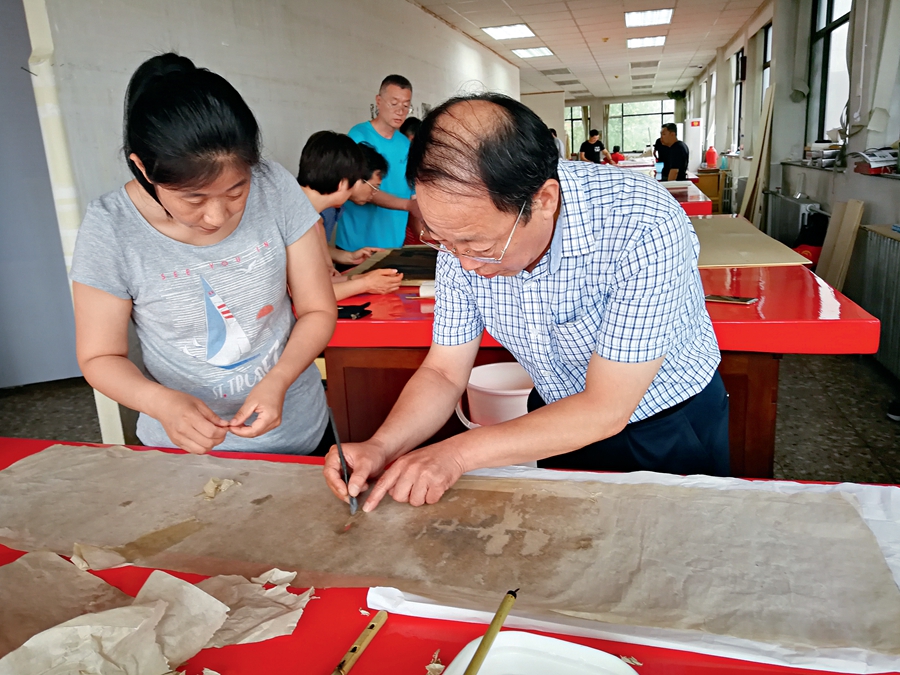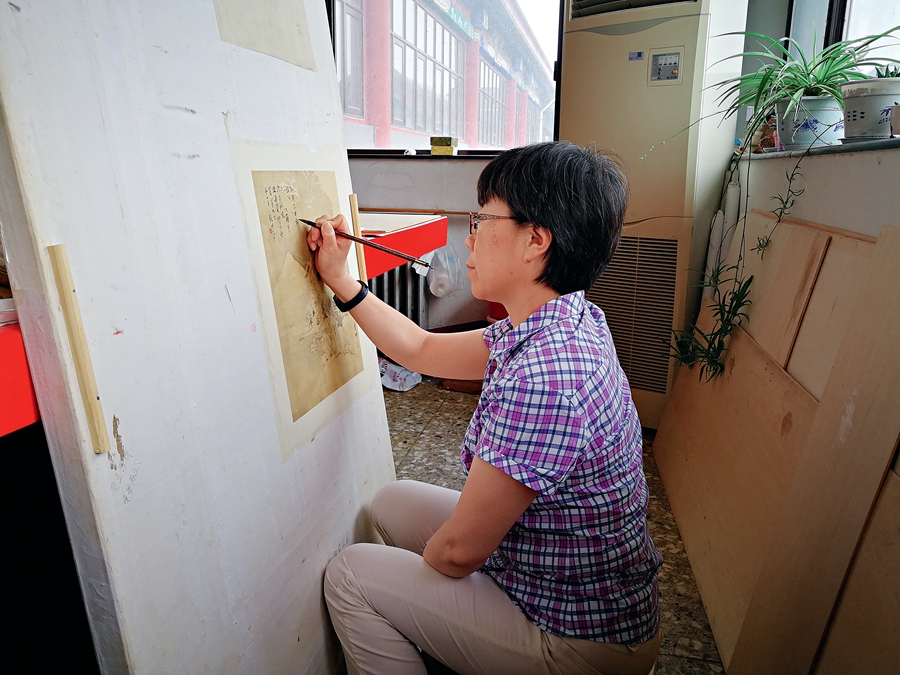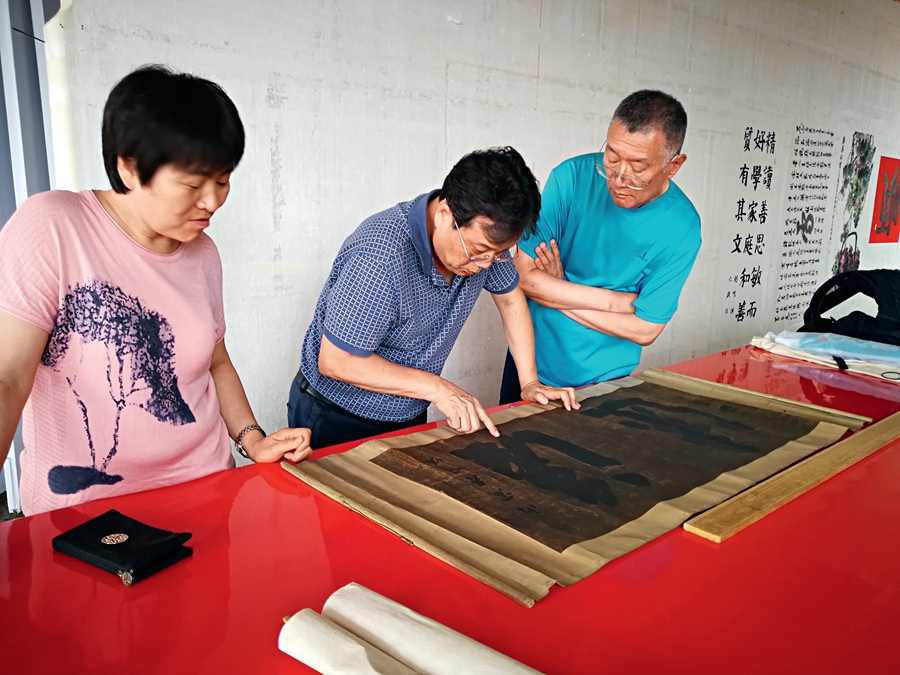A crucial reason that traditions and cultures can be passed down from generation to generation is because tangible cultural products such as paintings, calligraphies, and books are preserved for posterity. However, the aging process and improper conservation invariably results in damage or deterioration to these precious artifacts which, if left unattended, can mean a great loss to humanity.

Wang Xinjing, a national-level inheritor of mounting and restoration techniques of Rong Bao Zhai, a time-honored calligraphy and painting shop in Beijing, shows his apprentice how to repair an antique painting.
The restoration techniques for antique books, paintings, and calligraphies help to not only protect the existing cultural products, but also restore those that are damaged, making them available for public appreciation in museums, art galleries, and private collection exhibitions.
The Art of Mounting Paintings and Calligraphies
Mounting paintings and calligraphies aims to preserve the works and present them in an aesthetically pleasing manner. The craft became perfected between the Warring States Period (475 – 221 BC) and Western Han Dynasty (206 BC – AD 25). Well mounted pieces are not only conducive to the work’s preservation, but also in favor of its visual appeal. Traditional Chinese paintings and calligraphies are usually made on Xuanzhi (a high quality rice paper made in traditional ways) and silk. However, the Chinese ink containing a glue-like substance enhances the colorfastness, but over time makes the finished paintings or calligraphies wrinkled and crumbly. To make these works more durable and beautiful, the ancient Chinese craftspeople invented innovative mounting techniques in three steps. First, they pasted and trimmed relatively tough paper onto the back of the artwork to remove wrinkles and smooth out the paper. The glue, made from gluten free wheat flour, not only gave the work a smooth appearance but with the passing of time it formed a protective layer over the artwork. Second, they surrounded the artwork with decorative paper or silk fabrics. Finally a cobble stone would be rolled repeatedly across the surface to remove any air bubbles and then the work would either be framed or fitted with two rods to create a scroll and enable it to be hung or rolled up for safe storage.
Additional decorative materials can be applied based on different hues, compositions, and sizes of artworks.
Restoration Techniques of Paintings and Calligraphies
The restoration techniques of paintings and calligraphies are developed based on the mounting techniques. The restoration process requires the restorers’ great patience, high skill, and a lot of time. They need to remove the backing and other decorative parts first and then carefully clean the stains and mildew, as well as repair the damaged sections. After cleaning the work is remounted. The whole process involves over 20 steps, all done manually. Each step is closely linked to the other, so the previous step will affect the following one. Before restoring a piece of work, restorers also need to check the artwork’s information, such as when it was made, analyze what problems it has and under what temperature and humidity it was stored, so as to develop different restoration plans accordingly.

Li Shuzhen, a national-level inheritor of mounting and restoration techniques of Rong Bao Zhai, tries to make the hues of newly repaired parts compatible with the original.
The tools needed for the process include brush pens, brushes, tweezers, and blades. It is not easy to do it well without sustained and meticulous effort.
The first step is to assemble the damaged parts and link them together, resembling the process of a jigsaw puzzle. The second step involves removing the artwork from the backing paper, which is the most difficult step as the two are tightly stuck together. This task is difficult when done on a complete and undamaged painting, let alone on one which is aging and crumbling. It normally takes ten days to half a month to finish one piece. To maintain the correct level of humidity for the artworks, restorers use plastic film to cover the pieces when they take a break. The third step is to clean the surface, meaning to remove mildew, dust, and stains. Different methods are adopted according to different hues, ages, and other conditions of the artworks. Restorers work on a case-by-case basis: careful considerations are made concerning the temperature of water that is used to soak the painting or what suitable chemical liquid should be adopted.
The final step is to add the backing to the repaired painting. The restorers need to be very careful to avoid the paper cracking again as it is no longer a complete page. The restorers also need to make the hues of newly repaired parts compatible with the original. If it is a calligraphy work, the restorers need to complete the missing part of any Chinese character. After all the procedures are completed, the restorers mount the artwork again. According to Wang Xinjing, a national-level inheritor of mounting and restoration techniques of Rong Bao Zhai, a time-honored calligraphy and painting shop in Beijing, it normally takes two to three months to restore an artwork, and if the artwork is seriously damaged, it could take as long as half a year to one year.
In 2008, the mounting and restoration techniques of paintings and calligraphies of Rong Bao Zhai were included as a national intangible cultural heritage.
Restoration Techniques of Antique Books
Antique books refer to those produced before 1912 and feature the Chinese classical style of binding and layout. As non-renewable cultural resources, they play an important role in passing down the wisdom and culture of Chinese predecessors. The restoration of antique books is a special craft, which requires the restorers to be familiar with the forms and layout of books of different dynasties, their paper quality, the characteristics of cover, and the style of binding. Talented proficiency is a must for this job. The whole restoration process often involves ten-odd steps, all demanding meticulous manual work.

The restorers assess the conditions of an antique calligraphy and figure out the best restoration plan.
The craft has a history of over 1,000 years in China. Many men of letters and scholars made their contribution to its development. During its zenith, different schools were formed, among which the Shu School (Shu is generally a short term for Sichuan Province); rumors said it was widely appraised for its technique that was described as “reviving the artwork in a new guise.” Restorers with such technique could replace the damaged old paper, but allow the original writing to stay on the new sheets of paper, thus substantially extending the life of an antique book. It is a shame that the technique has been lost.
The restoration process is very complicated. Antique books suffer from a variety of problems such as bookworms, or rodent damage, acidic or oil stains, and loose and torn pages. Different books suffer from different problems depending on the climate in which they were stored. For example, books in south China in humid weather, are probably damaged by bookworm or mold. While books in the north, where the weather is dry, probably have pages that are brittle. Therefore, different restoration plans need to be made according to different conditions.
In addition, the restorers need to be versatile and have a good knowledge of various disciplines. They have to understand not only traditional culture relating to paper-making, printing, philology, different editions of ancient books, art, and Buddhism, but also science and technology relating to microorganisms, physics, and chemistry. These qualifications help the restorers understand the quality of paper and figure out the best restoration plan.
Nearly 30 tools are needed for the restoration work, including high-powered magnifying glasses, horseshoe-shaped knives, and awls. In addition, restorers sometimes need to create special tools to adapt to unique types of damage. The restoration procedure starts with separating the pages, making serial numbers on different pages or parts, and selecting proper paper. In fact, paper produced before the 20th century is hard to find now. So the restorers employ professional paper-making studios to reproduce the sheets according to the structure and ingredients of the old pages.
The most difficult step is to assemble the shreds of paper. Some books, damaged by worms or rodents, have been shredded into pieces, with the smallest ones being the size of a finger nail. If restorers cannot put these back together, the scraps are preserved until more qualified craftspeople are available to complete the process.
When repairing, the restorers use glue and brushes to carefully stick damaged parts onto new paper, flatten the new pages (which can take up to a month) punch holes and bind the book, which also demands meticulous efforts.
The ultimate goal is to have the repaired book look exactly like the old one in form. Some books are the only existing copies containing rich historical information, and valuable for the study of history. According to official statistics, public institutions around China have a collection of over 50 million antique books, which are invaluable assets. Among them over 10 million are in need of repair, so restorers have their work cut out for them.
In 2008, the techniques of restoring antique books were included as a national intangible cultural heritage.